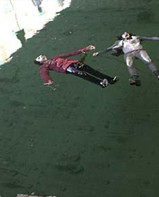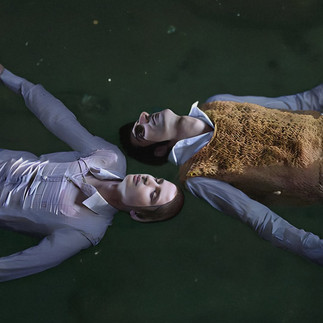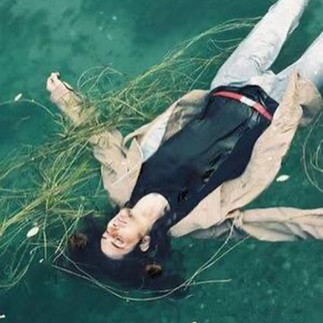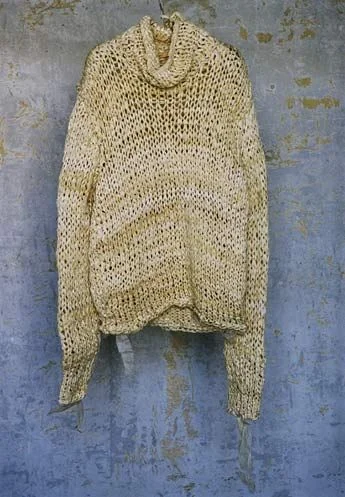Mainstream - Downstream
- kikokurative

- Jul 27
- 3 min read
Carol Christian Poell set us up
It’s June 25th, 2003, in Milan, along the Naviglio Grande canal. The air is hot and humid. Members of the press begin to arrive, but it’s difficult to tell where exactly the show is supposed to take place, at first glance, there’s nothing. Photographers scan the surroundings, dissecting every movement, waiting for something to happen. And then, suddenly, it does.
In the distance, a lifeless body appears, floating down the canal, arms crossed. For a few seconds, it looks like a tragic scene, a corpse drifting slowly through the water. Then it becomes clear : the Carol Christian Poell Spring/Summer 2004 show has just begun.
Bodies in the Current
More bodies follow, drifting silently in the polluted, foul-smelling canal. They’re dressed in blood-tinted leather, crisp white shirts, open-knit tops. There is no runway. No front row. No seating. The audience must walk along the riverbanks to keep up with the floating silhouettes. This was a show open to everyone. No exclusivity. No gatekeeping.

Ophelia and the Vitruvian Man
The scene evokes something deeper almost mythological. One can’t help but think of Ophelia, the tragic figure from Shakespeare, immortalized by Millais, lying in the water with her arms outstretched, face empty. The models, arms and legs extended, also recall Leonardo da Vinci’s Vitruvian Man, echoing the proportions of the human body as a universal measure.
Poell’s work, was not just about clothes, it was a message. The show’s title, Mainstream Downstream, was a metaphor for a fashion industry that moves mindlessly with the current.
“Nowadays, everything in the fashion industry moves in the same direction, like a river… I wanted to express my sense of crisis and cynicism toward it,” Poell said.
A Radical Gesture Against the Industry
Mainstream Downstream was not a fashion show, it was a conceptual performance. A poetic protest against the uniformity of the industry. Garments, bodies, water, spectators, and decay were all part of the same living installation. It fully embodied Poell’s anti-fashion ethos. This moment happened just as the industry was undergoing a profound transformation. Luxury conglomerates were expanding aggressively, acquiring independent houses and turning them into scalable global labels.

The Rise of the Conglomerates
Today, giants like LVMH or Kering have been firmly established for a long time. We’ve gotten used to seeing these massive groups scoop up almost every brand.
By 2001, Balenciaga had been acquired by PPR (the company that would become Kering in 2013). That same year, Alexander McQueen and Bottega Veneta were absorbed into the same group.
In 2002, Renzo Rosso, founder of Diesel, purchased 60% of Maison Martin Margiela through his group OTB. For Margiela, a house that had long stood for conceptual purity, this was a major shift. The brand entered a phase of commercial expansion : more stores, a stronger menswear line, increased production. All the while, Margiela himself remained silent, true to his disappearing act.
Poell’s show arrived in that context : a symbolic resistance to the wave of consolidation that was transforming fashion into an industrial machine. While others adapted or were absorbed, he chose absolute autonomy.

Clothing That Decays with Intention
But let’s come back to the garments in this show even though, for me, the scenography and symbolic power of Poell’s SS04 show overshadowed the clothes themselves.
The materials, especially the leather, were soaked in blood-red dyes, heightening the show’s morbid atmosphere. One knit resembled a sea sponge, paired with white trousers and a stark belt, a perfect look. And despite the heavy symbolism, Poell never sacrificed the quality of the garments.
The pieces underwent an irreversible transformation : soaked, stained, damaged by the dirty canal water. Some professionals tried to buy the clothes afterward, in the state they had emerged from the water. Poell refused. He claimed that the journey through the water was part of the piece itself. The process of decay was as much conceptual as it was visual.
I’ll leave you with a few looks from the SS04 season.
And finally, it’s worth emphasizing that more than 20 years later, Carol Christian Poell has never strayed from his path. He continues to operate entirely outside the traditional structures of the fashion industry : no luxury groups, no fashion weeks, no advertising campaigns. His work remains deeply artisanal, often experimental, and fully controlled by his own hand, from concept to execution.










































Comments